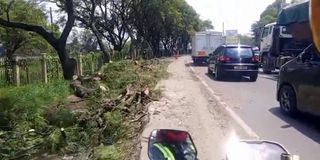Pruning for safety: Why Nakuru is cutting down weak trees

Traffic Snarl up after a tree fell on the highway on August 8, 2025 at Kenya Railways, just a few meters from Gate Iguru.
Along Nakuru’s highways and streets, trees form part of the city’s signature charm providing shade, softening the urban landscape, and keeping the air fresh.
But when branches grow too heavy or roots weaken, those same trees can turn from a blessing to a serious risk.
On Friday, August 8, that risk became a reality when a tree fell on the highway at Kenya Railways, just a few meters from Gate Iguru. The incident caused a major traffic snarl-up, briefly halting movement along the busy stretch.
According to Nakuru’s Chief Officer for Environment, Kennedy Mungai, the tree’s collapse was traced to weak root systems worsened by prolonged water stagnation and heavy rains.
“That area inside Kenya Railways tends to have water pooling, especially near the stopping point at Gate Iguru. Over time, the water seeps into the soil around the roots, making them rot. When you combine that with heavy branches and strong winds, it’s just a matter of time before the tree comes down,” Mungai explains in a phone interview with Mtaa Wangu.
Addressing the delay in response for the tree that fell on Friday, Mungai says emergency response can be challenging at night due to a lack of on-standby operators.
“The county often partners with the private sector, like millers for removals,” he notes.
On the question of compensation for victims injured by the trees, the chief officer states, “There is no compensation from the county for damages caused by falling trees. Victims must rely on personal insurance, which may only pay if vehicles were parked in designated areas. The County can only come in to collaborate on the statement that the damage that happened was not of your own doing."
Mungai further reveals that the Environment Department has been conducting countywide tree assessments, identifying and dealing with those posing the highest risks.
“We started in Shabab, then moved to Naivasha , Flamingo, and currently along the highway . It’s a continuous process. We remove or prune trees that are at risk of falling,” Mungai says, noting that trees inside institutional compounds, like the one at Kenya Railways, are ideally monitored by the institutions themselves.
However, the Friday incident was not the only case. Another tree recently fell close to State House.
On this Mungai, acknowledges the concern but notes it was not considered an immediate danger to the public and will be handled in due course.
He notes the county has also completed a large-scale removal of weakened trees along the Kabarak road, where construction work and age had left them unstable.
One of those trees had previously fallen on a vehicle, killing a passenger, a tragedy Mungai says reinforced the urgency of the program.
He says for emergencies the county is urging residents to use its Toll-Free Emergency Number: 0800724138 to report any trees leaning dangerously, with visible root damage, or showing signs of imminent collapse.
“The department is working to ensure motorists and residents can enjoy green cover without fearing what’s above their heads. Our goal is to keep Nakuru green, but safe, we can’t compromise public safety at any point. As for areas trees have been removed we plan to replant in the near future," he concludes.

